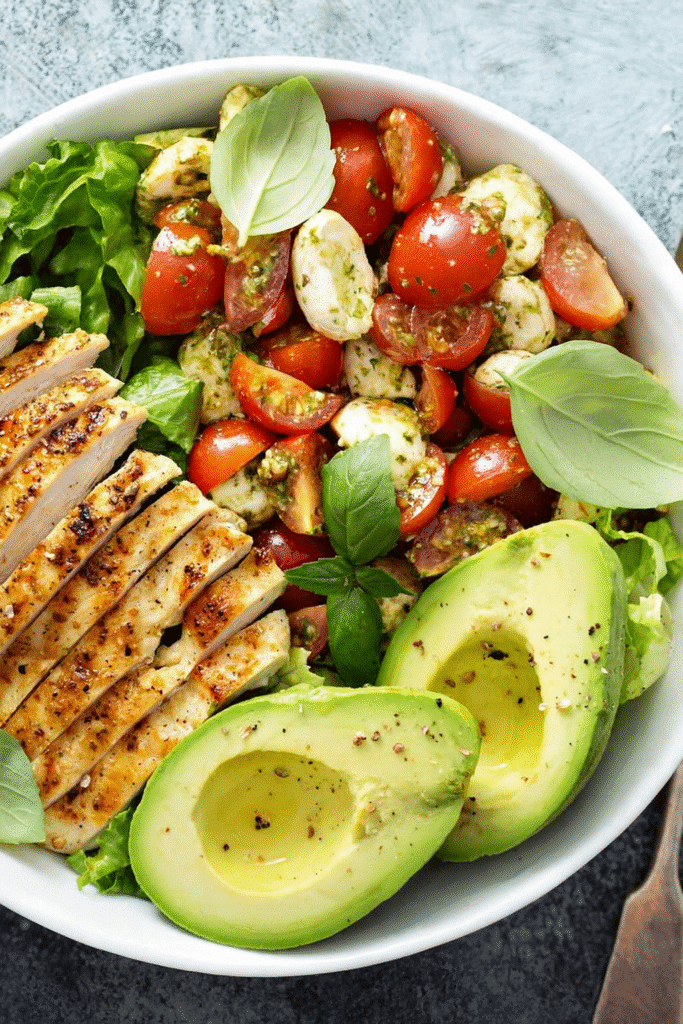Did you know chronic inflammation is linked to over 50% of modern diseases? That stat shook me. I was tired of feeling bloated, foggy, and just… off. That’s when I stumbled upon the 21-Day Anti-Inflammatory Diet—and honestly, it changed everything.
This guide will walk you through how to fight back with food. Think real meals, not restrictions. Think feeling energized again, not counting calories. And yes, you’ll still get to snack. Whether you’re trying to clear your skin, soothe your joints, or just feel more like you, this 21-day plan lays out the why, what, and how. Let’s dive in!

Table of Contents
Table of Contents
What Is the 21-Day Anti-Inflammatory Diet?
My Wake-Up Call
Okay, so let me be real for a second—when I first heard “anti-inflammatory diet,” I thought it was just another trendy buzzword. But I was exhausted, bloated all the time, and my joints ached like I was 70. Even though my bloodwork was “normal,” I knew something wasn’t right.
That’s when a friend told me about the 21-Day Anti-Inflammatory Diet. She said it helped her feel like herself again. Skeptical but desperate, I gave it a go.
What Inflammation Really Means
Here’s the deal: inflammation isn’t always about obvious swelling. Chronic inflammation is sneaky. It can cause fatigue, digestive issues, mood swings, and even skin flare-ups. It’s your immune system constantly “on,” and over time, it wears you down.
The scary part? It’s linked to serious stuff like heart disease, diabetes, and autoimmune conditions.
The 3-Week Reset Explained
The 21-Day Anti-Inflammatory Diet is basically a 3-week food reboot. You remove pro-inflammatory stuff like:
- Processed snacks
- Added sugars
- Refined oils
- Red and processed meats
And instead, you load up on:
- Leafy greens
- Bright berries
- Omega-3 rich fish
- Turmeric, ginger, garlic
- Olive oil, nuts, seeds
It’s real food that helps your body chill out and heal.
My Real Results
By week two, I noticed my energy was up. Like, actually up. My brain fog lifted, I slept better, and my belly wasn’t screaming after meals. My skin even cleared up—wasn’t expecting that!
The meals were delicious too. Think: roasted veggie bowls, smoothies with almond butter, turmeric chicken with wild rice. No sad salads here.
Why It’s Worth Trying
If your body feels “off” and you can’t figure out why, this plan might just help you reset. You don’t need to do it perfectly. Just give your body a break from the stuff that inflames it.
For me, those 21 days were the start of a whole new relationship with food—and my health.
Grocery Staples for the 3-Week Plan
Why Planning Ahead Saved My Sanity
The first time I tried the 21-Day Anti-Inflammatory Diet, I made the rookie mistake of winging it. I had no idea what to buy, ended up with half a cart of random health foods… and still nothing to make an actual meal.
The second time? I made a plan. I batch-shopped. And let me tell you—it made everything so much easier. No more 7 p.m. pantry panics.
Produce That Powers Your Gut
Here’s what went in my cart first:
- Leafy greens (kale, spinach, arugula)
- Cruciferous veggies (broccoli, cauliflower, Brussels sprouts)
- Colorful stuff: bell peppers, carrots, zucchini
- Berries (blueberries, raspberries, strawberries)
- Avocados (because duh)
These are your anti-inflammatory MVPs. They’re loaded with antioxidants, fiber, and compounds your body actually uses to repair itself.
Proteins That Heal, Not Harm
You’re not giving up protein—just trading up:
- Salmon and sardines (hello, omega-3s)
- Chicken breast (pasture-raised if possible)
- Eggs
- Lentils and chickpeas
- Tofu and tempeh
If you’re plant-based, those beans and tofu will be your new best friends.
Smart Grains & Comfort Carbs
Don’t ditch carbs—just pick the right ones:
- Quinoa
- Brown rice
- Rolled oats
- Buckwheat
- Sweet potatoes
These give you long-lasting energy without the sugar crash.
Fats That Don’t Feed the Fire
Your body needs fat—but it better be the right kind:
- Extra virgin olive oil
- Coconut oil (for high-heat cooking)
- Almonds, walnuts, and pumpkin seeds
- Nut butters (natural only—check for no added sugar!)
Pro tip: I kept a small container of mixed nuts in my car for snack emergencies. Lifesaver.
Herbs, Spices & Sips
Flavor = satisfaction. These anti-inflammatory add-ons made meals way better:
- Turmeric, ginger, cinnamon, garlic
- Apple cider vinegar
- Herbal teas (peppermint, green, chamomile)
- Lemon and fresh herbs for brightness
And yep—coffee is still on the menu (in moderation). I just switched to almond milk and ditched the syrup.
Kitchen Hacks to Save Time
By week two, I started:
- Chopping and pre-washing veggies on Sundays
- Pre-cooking grains and proteins in batches
- Freezing smoothie packs (game-changer)
- Keeping roasted sweet potatoes in the fridge (they go with everything)
Having staples on hand made the 21-Day Anti-Inflammatory Diet way less stressful. And honestly? Kinda fun once I got the rhythm.
Weekly Meal Plans (Week 1–3 Overview)
The First Week: Reset Mode
Let me tell you—Week 1 of the 21-Day Anti-Inflammatory Diet was rough… and then amazing. That first grocery run had me low-key panicking (“What even is buckwheat?!”). But once I had meals planned out, things started to click.
Here’s how I kept it simple but tasty:
Sample Day (Week 1):
- Breakfast: Blueberry chia pudding with almond milk
- Lunch: Grilled chicken quinoa bowl with roasted veggies
- Snack: A handful of walnuts + apple slices
- Dinner: Turmeric salmon with steamed broccoli and sweet potato
That first week, I stuck to basic recipes and repeated a lot of meals. Not fancy—but it worked. I focused on calming my gut, drinking lots of water, and sleeping more. That combo? Chef’s kiss.
Week 2: Rebuild & Rotate
By Week 2, I got brave. I started rotating ingredients, trying new stuff like lentil tacos and cauliflower stir-fry. I even made my own anti-inflammatory dressing (olive oil, lemon juice, turmeric, garlic—easy and 🔥).
New Faves I Tried:
- Green smoothies with spinach, banana, flaxseed, and ginger
- Veggie-packed soups with bone broth
- Roasted chickpeas for snackin’
- Baked sweet potato with black beans and avocado
This week was about variety and building momentum. Plus, I had fewer cravings and started waking up without the groggy hangover feeling. Huge win.
Week 3: Reinforce & Thrive
Here’s where the magic happened. By Week 3, I wanted to keep eating this way. My energy was up, my skin looked clearer, and even my weird shoulder ache chilled out.
What I Focused on:
- Swapping in new proteins like shrimp or tempeh
- Trying one new spice each day (hello, smoked paprika!)
- Doubling dinner portions to use for lunch the next day
- Making Sunday a prep-and-rest day
I wasn’t perfect—and that’s okay. I still had a few “meh” meals. But overall, Week 3 felt like confirmation that my body was finally exhaling.
Tips to Make Meal Planning Easier
- Repeat favorites: Don’t stress about creating a new meal every day
- Theme days: “Smoothie Monday,” “Soup Wednesday,” “Taco Friday”
- Leftover magic: Turn roasted veggies into breakfast hash
- Stay flexible: If dinner flops, just eat a bowl of oats. Seriously, no shame.
Meal planning during the 21-Day Anti-Inflammatory Diet isn’t about gourmet dishes—it’s about consistency and progress. And spoiler alert: you will get better at it.
Recipes That Heal—Top Meals You’ll Crave
My Cooking Reality Check
So… true story: the first time I tried making “anti-inflammatory” meals, I ended up with a sad bowl of steamed broccoli and dry chicken. Not exactly crave-worthy. But once I found the right recipes? Game. Changer.
During the 21-Day Anti-Inflammatory Diet, flavor has to be your best friend—or you won’t stick with it.
Here are a few meals that actually made me excited to eat (and kept me away from the drive-thru).
🥣 Breakfasts That Keep You Full
Mornings used to be just coffee and regret. Now?
- Golden Oats: Rolled oats with almond milk, cinnamon, turmeric, maple syrup, and berries. So cozy.
- Berry Smoothie: Spinach, frozen blueberries, flaxseeds, banana, ginger, and almond butter. Tastes like dessert, fuels like magic.
- Avocado Toast Upgrade: Sprouted grain bread + smashed avocado + hemp seeds + chili flakes.
Tip: prep smoothie bags and overnight oats the night before. Zero stress, full flavor.
🥗 Lunches That Don’t Suck
Let’s be honest—salads can be a snooze. But these? Not even close:
- Quinoa Power Bowl: Quinoa, roasted sweet potato, black beans, avocado, kale, and a lemon-tahini dressing.
- Lentil Veggie Soup: Hearty, herby, and budget-friendly. I made a big pot and lived off it for days.
- Rainbow Wraps: Collard greens wrapped around hummus, shredded carrots, red cabbage, and grilled tofu. No soggy tortilla here.
Pro tip: Double your dinner and call it lunch. Easy.
🍽️ Dinners You’ll Want Seconds Of
Dinner used to be my weakest link—I’d crash and reach for takeout. These saved me:
- Turmeric Salmon with Roasted Cauliflower: Drizzle with olive oil, toss in cumin, roast it all. Fancy without the effort.
- Stuffed Sweet Potatoes: Fill ’em with lentils, sautéed onions, spinach, and top with salsa. So filling.
- Zucchini Noodles + Garlic Shrimp: Light but super satisfying. Garlic and chili flakes make it pop.
I also kept frozen riced cauliflower on hand for quick stir-fries. Lifesaver.
🍫 Snacks & Sweets (Yes, Really)
The 21-Day Anti-Inflammatory Diet isn’t about suffering. You can treat yourself smartly:
- Dark Chocolate + Almond Butter (heaven)
- Frozen Grapes (underrated!)
- Coconut Yogurt with Berries + Chia
- Matcha Latte with Oat Milk (gives you that cozy vibe without inflammation)
Bonus: I made turmeric “golden milk” at night with almond milk and cinnamon. It knocked me out in the best way.
Cooking Tips I Learned the Hard Way
- Don’t fear the spice rack—flavor = satisfaction
- Double batches—cook once, eat twice
- Use sheet pans—roast everything at once
- Embrace one-pot meals—less cleanup, more time to chill
I thought eating this way would be bland and boring. Instead? It made me feel like a low-key chef and actually look forward to meals again.
Lifestyle Habits That Support the Diet
It’s Not Just About the Food
Quick confession: I used to think the 21-Day Anti-Inflammatory Diet was only about what’s on your plate. I was wrong—like, big-time wrong.
Turns out, you can eat all the turmeric in the world, but if you’re living in a stress spiral and sleeping 5 hours a night? Your body’s still inflamed. Harsh truth, but it made me rethink the whole picture.
Stress Is Fuel for Inflammation
During my first week, I noticed that when I was frazzled, even clean meals didn’t make me feel better. So I started adding little things to calm my system:
- 5-minute breathing breaks (set a timer—no cheating)
- Stretching before bed—even just lying on the floor with legs up a wall helped
- Saying “no” more (took practice, but so worth it)
Stress reduction isn’t woo-woo—it’s survival, especially when you’re trying to heal.
Sleep Like It’s Your Job
I didn’t realize how jacked-up my sleep was until I started tracking it. Night 3 of the diet, I turned off Netflix early, drank golden milk, and bam—I slept straight through for the first time in weeks.
Now, I aim for:
- 7–9 hours of real sleep (not scrolling in bed sleep)
- No screens 30 mins before bed
- Cool, dark room—I even bought blackout curtains on sale
I wake up clearer, less puffy, and weirdly more optimistic. Coincidence? I doubt it.
Movement Helps the Magic Happen
You don’t need to crush it at the gym. In fact, when I was doing high-intensity workouts daily, I stayed inflamed. Walking, yoga, and even just dancing in my kitchen made a bigger impact.
What worked for me:
- 20-minute daily walks (rain or shine, honestly therapeutic)
- Gentle yoga flows from YouTube
- Short mobility sessions during podcast time
Moving your body tells your nervous system “we’re safe now.” That’s huge when trying to lower inflammation.
Supplements & Sips That Helped
Not required, but these were MVPs during my 21-Day Anti-Inflammatory Diet:
- Turmeric + black pepper capsules (way easier than cooking with it daily)
- Magnesium glycinate (great for sleep and muscle tension)
- Green tea or matcha for a clean energy boost
- Probiotic-rich drinks like kombucha (watch for added sugar though)
I kept a mental note: no one thing fixes everything, but small shifts stacked daily = big change.
Final Word: Treat the Whole You
The 21-Day Anti-Inflammatory Diet isn’t just about “eating right.” It’s about lowering the load on your body from all angles. Rest, relax, move gently, and give yourself grace. Those lifestyle changes? They’re the glue that holds it all together.
21-Day Diet Tracker & Success Journal
The Tool That Kept Me Going
Let me be honest: I almost gave up halfway through Week 2 of the 21-Day Anti-Inflammatory Diet. Not because the meals were bad, but because I couldn’t see my progress. That’s when I started tracking everything—and it completely changed the game.
Having a little notebook (or a notes app, no judgment) helped me stay motivated, honest, and curious about what my body was doing.
What I Tracked (and Why It Helped)
Nothing fancy—just the basics:
- Meals & snacks
- Energy levels (morning, midday, evening)
- Mood and stress
- Sleep hours and quality
- Digestion (yeah, I went there—it matters!)
Some days I’d look back and realize I felt amazing after a quinoa bowl but sluggish after a rice-heavy dinner. It helped me spot patterns and tweak my meals instead of quitting entirely.
Daily Checklists for Sanity
Each morning, I’d jot down:
- What I planned to eat
- One small goal (like “stretch for 10 minutes”)
- One thing I was grateful for (kept my head right)
Then at night, I’d check in:
- Did I eat mostly anti-inflammatory foods?
- Did I move my body?
- How was my mood and sleep?
Keeping it simple made it sustainable.
Prompts That Got Me Reflecting
Here’s what I asked myself during the 21-Day Anti-Inflammatory Diet:
- “What felt easy today?”
- “What tripped me up?”
- “What’s one small thing I can do better tomorrow?”
- “What’s changed since Day 1?”
Writing it out helped me appreciate the little wins—like not craving sugar for once, or actually feeling good in the morning.
Printables & Digital Tools I Loved
I ended up printing a weekly meal grid and using highlighters to mark my progress (yeah, I’m that person). If you’re more digital, there are apps like Daylio, Streaks, or even just Google Sheets to log everything.
Want to go old-school? A plain notebook works perfectly.
Why It’s Worth the Effort
Tracking made the 21-Day Anti-Inflammatory Diet feel doable. Instead of guessing or relying on memory, I had receipts. Literal proof that I was getting better, even when the scale didn’t budge or my jeans still felt tight.
And on rough days? Those notes reminded me how far I’d come.
Conclusion: Start Your 21-Day Reset Today
If you’ve made it this far, you’re probably more than just curious about the 21-Day Anti-Inflammatory Diet. Maybe you’re tired of waking up groggy, sick of chasing energy with caffeine, or just ready to feel like yourself again. I’ve been there.
This isn’t about being perfect for 21 days. It’s about giving your body a break, showing it a little love, and seeing what happens when you actually eat foods that help you heal instead of hurt.
Start with one meal. Just one. Then maybe a full day. Then a week. Before you know it, you’re sleeping better, moving easier, and actually enjoying the food on your plate. That momentum? It builds.
And hey—if this guide helped you even a little, do me a favor and share it on Pinterest. Pin it, save it, send it to your friend who’s always “trying to eat clean.” You never know who needs this nudge.
You’ve got this. Your body’s been waiting for it.


